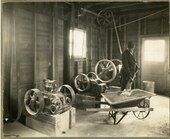Mineral processing
Before the advent of heavy machinery, raw ore was broken up using hammers wielded by hand, a process called "spalling".[2] A later example was the Cornish stamps, consisting of a series of iron hammers mounted in a vertical frame, raised by cams on the shaft of a waterwheel and falling onto the ore under gravity.[3] A bloomery is the original form of smelting and allowed people to make fires hot enough to melt oxides into a liquid that separates from the iron.Although the bloomery was promptly phased out by the invention of the blast furnace, it was still heavily relied on in Africa and Europe until the early part of the second millennium.In 1856 the Bessemer process was invented that turns the brittle pig iron into steel, a more malleable metal.[4] Since then, many different technologies have been invented to replace the Bessemer process such as the electric arc furnace, basic oxygen steelmaking, and direct reduced iron (DRI).Roasting is the primary method of separating, where wood was placed on heaps of ore and set on fire to help with oxidation.[6][7] The earliest practices of roasting were done outside, allowing large clouds of sulfur dioxide to blow over the land causing serious harm to surrounding ecosystems, both aquatic and terrestrial.The clouds of sulfur dioxide combined with local deforestation for wood needed for roasting compounded damages to the environment,[6] as seen in Sudbury, Ontario and the Inco Superstack.Another comparatively simple method relies on the various minerals having different densities, causing them to collect in different places: metallic minerals (being heavier) will drop out of suspension more quickly than lighter ones, which will be carried further by a stream of water.Other equipment used historically includes the hutch, a trough used with some ore-dressing machines and the keeve or kieve, a large tub used for differential settlement.To do this, the mineralogy of the ore needs to be considered as this dictates the amount of liberation required and the processes that can occur.The smaller the particles processes, the greater the theoretical grade and recovery of the final product.In this way the separation takes place purely on density differences and does not, in principle, relay on any other factors such as particle weight or shape.These include, organic liquids, aqueous solutions or suspensions of very fine particles in water or air.Of the gravity separation processes, the spiral concentrators and circular jigs are two of the most economical due to their simplicity and use of space.The washwater spirals separate particles more easily but can have issues with entrainment of gangue with the concentrate produced.The frothers are another important chemical addition to the pulp or slurry as they enable stable bubbles to be formed.Electrostatic plate separators work by passing a stream of particles past a charged anode.The conductors lose electrons to the plate and are pulled away from the other particles due to the induced attraction to the anode.Modern, automated sorting applies optical sensors (visible spectrum, near infrared, X-ray, ultraviolet), that can be coupled with electrical conductivity and magnetic susceptibility sensors, to control the mechanical separation of ore into two or more categories on an individual rock by rock basis.Sensor based sorting has found application in the processing of nickel, gold, copper, coal and diamonds.This is done for a number of reasons, specifically, to enable ore handling and concentrates to be transported easily, allow further processing to occur and to dispose of the gangue.This process is only viable for coarse ores that have a close size distribution as the apertures can allow small particles to pass through.To aid in the sedimentation process, flocculants and coagulants are added to reduce the repulsive forces between the particles.Many mechanical plants also incorporate hydrometallurgical or pyrometallurgical processes as part of an extractive metallurgical operation.This includes the study of oil agglomeration[21][22][23][24] A number of auxiliary materials handling operations are also considered a branch of mineral processing such as storage (as in bin design), conveying, sampling, weighing, slurry transport, and pneumatic transport.The efficiency and efficacy of many processing techniques are influenced by upstream activities such as mining method and blending.[26] EMC, the European Metallurgical Conference has developed to the most important networking business event dedicated to the non-ferrous metals industry in Europe.The conference is held every two years by invitation of GDMB Society of Metallurgists and Miners and is particularly directed to metal producers, plant manufactures, equipment suppliers and service providers as well as members of universities and consultants.




comminutionmineralsextractive metallurgyeconomic valuegangueore concentratetailingsrecoveryCornishspallingstamp millsSamarkandPersiaearly medieval periodmedieval Islamic worldIslamic SpainCentral AsiaCornish stampswaterwheelbloomeryblast furnacesmeltingpig ironBessemer processelectric arc furnacebasic oxygen steelmakingdirect reduced ironRoastingsulfur dioxideSudburyOntarioInco SuperstackdensitiesFrue vannergravity separationmagnetic separationFroth flotationleachingelectrowinningscreeningDewateringCrushinggrindingball millsore sortersgas cycloneshydrocyclonestrommelsparticle size analysisspecific gravitymicronsamenabilityWilfley tableSpiral separatorsJig concentratorsKnelson concentratorElutriatorssurfactantsphaleriteJameson Cellelectrostatic separatorsstream of particlesmineral sandszirconrutileilmenitewolframitecassiteritebelt pressfilter pressmechanical plantshydrometallurgicalpyrometallurgicalGeometallurgymaterials handlingblendingCoal preparation plantSensor-based sortingDartmoor tin-miningRocker boxRefining (metallurgy)TaconiteBibcodeWayback MachineBerlinSpringerLondonGeological SocietyMetallurgical assayNon-ferrous extractive metallurgyGeological surveyNatural resourcesEconomic geologyMineralBase metalPrecious metalMiningSurfaceUnderground in hard rockUnderground in soft rockRecyclingStamp millArrastraCrusherBall millIsaMillOre sortingVanningHydrocycloneTrommelCyclonic separationGyratory equipmentMechanical screeningConcentrationPanningMagnetationDry washingBuddle pitPyrometallurgyIron smeltingLead smeltingZinc smeltingFlash smeltingISASMELTRefractory liningsRefining